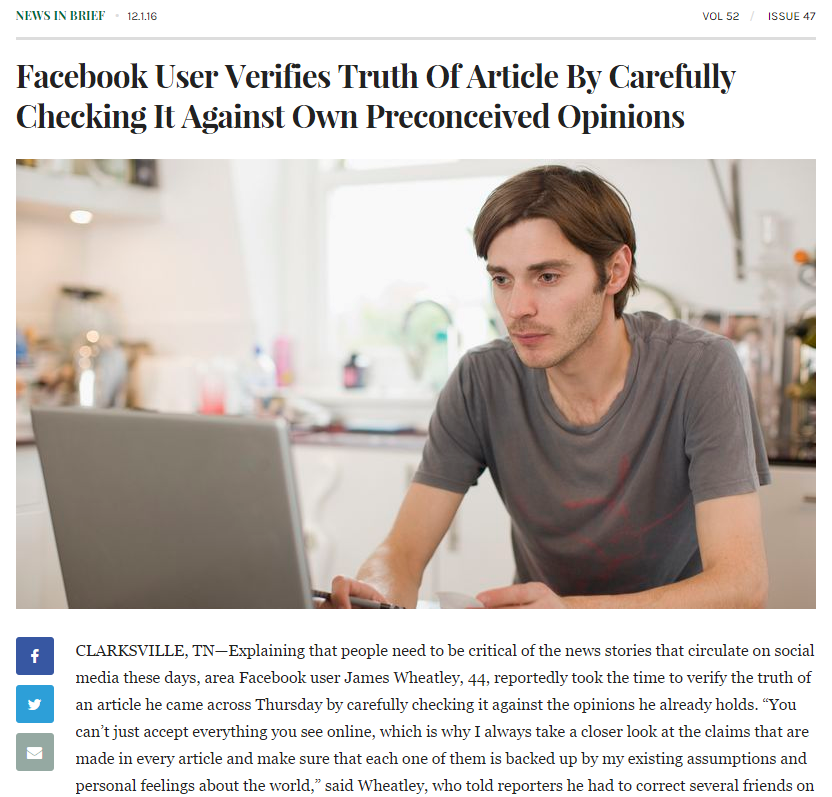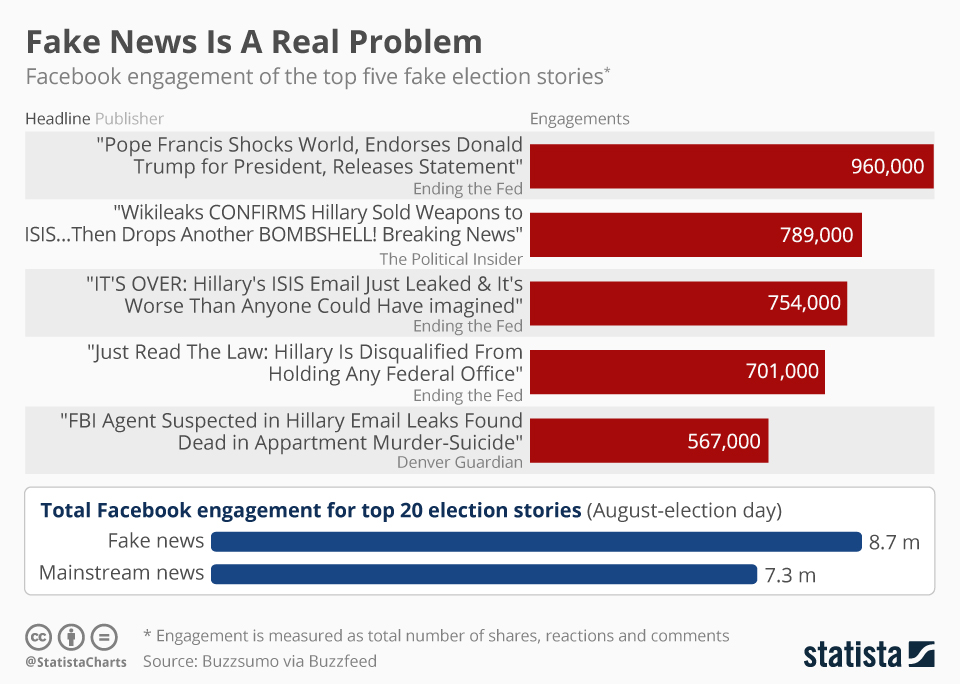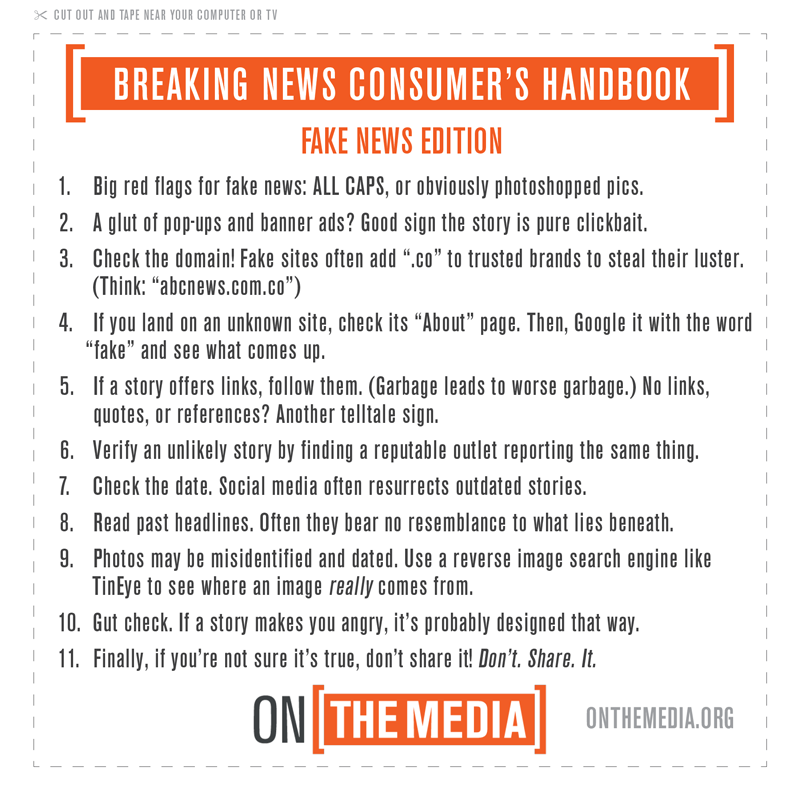"Fake news" is a term used to describe lies masquerading as news. This could be satire -- The Onion is one example of how to successfully use a newspaper-like format for making comedic social commentary. But we all know The Onion is fake. It is completely transparent in its lies, so when we see something from The Onion, we laugh and know not to believe a single word. But more often, online "news" sites are making up fake news for non-satirical purposes, and those words are taken as truth.
WNYC's Breaking News Consumer's Handbook: Fake News Edition. In this 9-minute episode, Melissa Zimdars discusses "how to be a savvy news consumer in a misinformation-filled world." Zimdars has made a list of more than a hundred problematic news sites.
Oxford Dictionaries named Post-Truth as the 2016 Word of the Year. According to Oxford, the definition of Post-Truth is "Relating to or denoting circumstances in which objective facts are less influential in shaping public opinion than appeals to emotion and personal belief." Objective facts are becoming less significant than click-bait stories that elicit emotion and validate what we already believe, while Post-Truth politics has picked up steam across the world, most notably in the United States, Germany and the UK.
The OCOM Librarians believe the search for the truth is a process, one that takes work. In an era of "Alternative Facts" and fake news, you can't just wait for the truth to show up in your Facebook feed. This guide will provide a basic understanding of "Fake News" and bias, and will give you the tools to decipher the noise from the facts. It is work, but in a Post-Truth era, being information literate has never been so important.
The OCOM Librarians believe the search for the truth is a process, one that takes work. In an era of "Alternative Facts" and fake news, you can't just wait for the truth to show up in your Facebook feed. This guide will provide a basic understanding of "Fake News" and bias, and will give you the tools to decipher the noise from the facts. It is work, but in a Post-Truth era, being information literate has never been so important.
1.
Oxford Dictionaries Word of the Year 2016 is... Post-Truth. Oxford Dictionaries. https://www.oxforddictionaries.com/press/news/2016/11/17/WOTY-16. Published November 16, 2016. Accessed February 17, 2017.
2.
Broadcast news is losing its balance in the post-truth era. The Guardian. https://www.theguardian.com/media/2012/sep/09/post-truth-politics-us-broadcasting. Published September 8, 2012. Retrieved February 21, 2017.
NATIVE ADVERTISING
To be fair, Native Advertising isn't necessarily false information. But it is biased information. Native Advertising is the process of hiding advertisements so they blend in with regular content. Some Native Advertisements are blatantly biased ads, while others are well-researched and informative -- but it is important to remember that even "good" Native Ads are still ads.
Example of "good" Native Advertising

(click to view full piece)
CLICKBAIT & FAKE NEWS
During the 2016 election cycle, there was a huge increase in fake news sites. Some were created to generate income as clickbait, while others were used to falsely discredit political opponents. Both had the same outcome, though: the completely made-up and fake news reports were believed and shared by our nation, vastly changing the way we view news media in the United States.

SATIRE
Satirical news sites often use lies to make social commentary, and in the case of The Onion, do it in a funny way. These are normally pretty obvious, but sometimes sites that intend to be satirical are read as literal. When people read information on the web without a critical lens, misinformation can spread like wildfire.

One of the most concerning things about Fake News is that we now know that people have a difficult time parsing truth from lies, recognizing reliable resources, and double-checking the validity of news stories. According to a Stanford study1, more than 80% of the 203 middle-schoolers studied could not differentiate Native Advertising from regular content. Over 40% of the high-schoolers surveyed believed pictoral evidence was irrefutable, while college students had a difficult time explaining the reliability of information shared on social media. And according to a 2014 study2 by the American Press Institute, six out of ten Americans had not delved deeper than reading headlines in the past week.
1.
Wineburg S, McGrew S, Breakstone J, Ortega T. Evaluating Information: The Cornerstone of Civic Online Reasoning. Stanford University; 2016. http://purl.stanford.edu/fv751yt5934. Accessed February 17, 2017.
2.
American Press Institute. How Americans get their news. American Press Institute. https://www.americanpressinstitute.org/publications/reports/survey-research/how-americans-get-news/. Published March 13, 2014. Accessed February 17, 2017.
Between 2002-2005, Elsevier was paid an undisclosed sum to publish an academic medical journal by Merck, a large pharmaceutical company. The journal issues were a compilation of journal articles that painted Merck products in a positive light. Some of the articles appeared to be reprints from peer-reviewed journals, while the origin of others was unclear. The journal was marketed to look like a peer-reviewed journal, and did not disclose that Merck was paying for its publication.
Though the articles in this case may have gone through the peer-review process, the fact remains -- the articles were paid for by a pharmaceutical company to act as an advertisement, and this fact was not disclosed. By curating a collection of articles that were only favorable to Merck products, physicians and medical researchers were being presented with a biased view of the research.
1. Singer N. Merck paid for medical “journal” without disclosure. The New York Times. https://www.nytimes.com/2009/05/14/ business/14vioxxside.html. Published May 13, 2009. Accessed February 21, 2017.
Though the articles in this case may have gone through the peer-review process, the fact remains -- the articles were paid for by a pharmaceutical company to act as an advertisement, and this fact was not disclosed. By curating a collection of articles that were only favorable to Merck products, physicians and medical researchers were being presented with a biased view of the research.
1. Singer N. Merck paid for medical “journal” without disclosure. The New York Times. https://www.nytimes.com/2009/05/14/ business/14vioxxside.html. Published May 13, 2009. Accessed February 21, 2017.
If you look at the sources for each of these fake stories, you'll notice a pattern -- all five of these articles were from three very popular (and completely fake) sites: Ending the Fed, The Political Insider, and Denver Guardian. You can read an NPR interview with the creator of Denver Guardian here.
The SIFT method is an easy way to use the skills that professional fact-checkers employ to determine the credibility of an online source. The videos below will give you the knowledge you need to learn these skills in under 13 minutes.


The SIFT method was created by Mike Caulfield. All SIFT information on this page is adapted from his materials with a CC BY 4.0 license. Use the SIFT method to help you analyze information, especially news or other online media.
Web Literacy for Student Fact-Checkers
This ebook by Mike Caulfield is freely available online under a CC BY 4.0 license
Check, Please! Starter Course
A free, five-lesson course on fact- and source-checking from Mike Caulfield
A free, five-lesson course on fact- and source-checking from Mike Caulfield
Hapgood, Mike Caulfield's Blog
This is Mike Caulfield's Blog where he explains SIFT in his own words.
SIFTing Through the Pandemic
Another Mike Caulfield creation, this blog focuses on using SIFT during the COVID-19 pandemic.
1.
Barthel M, Mitchell A, Holcomb J. Many Americans Believe Fake News Is Sowing Confusion. Pew Research Center’s Journalism Project. December 2016. http://www.journalism.org/2016/12/15/many-americans-believe-fake-news-is-sowing-confusion/. Accessed February 17, 2017.
2.
Manjoo F. How the Internet Is Loosening Our Grip on the Truth. The New York Times. https://www.nytimes.com/2016/11/03/technology/how-the-internet-is-loosening-our-grip-on-the-truth.html. Published November 2, 2016. Accessed February 17, 2017.
3.
Fake news and the spread of misinformation. Journalist’s Resource. January 2017. https://journalistsresource.org/studies/society/internet/fake-news-conspiracy-theories-journalism-research. Accessed February 17, 2017.
4.
Lies, Damn Lies and Viral Content |. http://towcenter.org/research/lies-damn-lies-and-viral-content/. Accessed February 17, 2017.
1.
Isaac NW Mike, Benner K. Google and Facebook Take Aim at Fake News Sites. The New York Times. https://www.nytimes.com/2016/11/15/technology/google-will-ban-websites-that-host-fake-news-from-using-its-ad-service.html. Published November 14, 2016. Accessed February 17, 2017.
2.
Leetaru K. How Data And Information Literacy Could End Fake News. Forbes. http://www.forbes.com/sites/kalevleetaru/2016/12/11/how-data-and-information-literacy-could-end-fake-news/. Accessed February 17, 2017.
3.
Menczer F. Misinformation on social media: Can technology save us? The Conversation. http://theconversation.com/misinformation-on-social-media-can-technology-save-us-69264. Accessed February 17, 2017.
4.
A Finder’s Guide To Facts. NPR.org. http://www.npr.org/2016/12/11/505154631/a-finders-guide-to-facts. Accessed February 17, 2017.
5.
How to Stop the Spread of Fake News. http://www.nytimes.com/roomfordebate/2016/11/22/how-to-stop-the-spread-of-fake-news. Accessed February 17, 2017.
1.
Coler J, Sites P of FN. We Tracked Down A Fake-News Creator In The Suburbs. Here’s What We Learned. NPR.org. http://www.npr.org/sections/alltechconsidered/2016/11/23/503146770/npr-finds-the-head-of-a-covert-fake-news-operation-in-the-suburbs. Accessed February 17, 2017.
2.
Dewey C, Dewey C. Facebook fake-news writer: “I think Donald Trump is in the White House because of me.” The Washington Post. https://www.washingtonpost.com/news/the-intersect/wp/2016/11/17/facebook-fake-news-writer-i-think-donald-trump-is-in-the-white-house-because-of-me/?tid=sm_tw&utm_term=.9608852d2222. Published November 17, 2016. Accessed February 17, 2017.
3.
Maheshwari S. How Fake News Goes Viral: A Case Study. The New York Times. https://www.nytimes.com/2016/11/20/business/media/how-fake-news-spreads.html. Published November 20, 2016. Accessed February 17, 2017.
4.
Shane S. From Headline to Photograph, a Fake News Masterpiece. The New York Times. https://www.nytimes.com/2017/01/18/us/fake-news-hillary-clinton-cameron-harris.html. Published January 18, 2017. Accessed February 17, 2017.
5.
Stack L. 20th Century Fox Used Fake News to Publicize “A Cure for Wellness.” The New York Times. https://www.nytimes.com/2017/02/15/arts/fake-news-a-cure-for-wellness-movie.html. Published February 15, 2017. Accessed February 17, 2017.
6.
Stelter B. Fake news, real violence: “Pizzagate” and the consequences of an Internet echo chamber. CNNMoney. http://money.cnn.com/2016/12/05/media/fake-news-real-violence-pizzagate/index.html. Published December 5, 2016. Accessed February 17, 2017.
1.
Allcott H, Gentzkow M. Social Media and Fake News in the 2016 Election. National Bureau of Economic Research; 2017. doi:10.3386/w23089. http://www.nber.org/papers/w23089
2.
Balmas M. When Fake News Becomes Real: Combined Exposure to Multiple News Sources and Political Attitudes of Inefficacy, Alienation, and Cynicism. Communication Research. 2014;41(3):430–454. http://journals.sagepub.com/doi/abs/10.1177/0093650212453600
3.
Marchi R. With Facebook, blogs, and fake news, teens reject journalistic “objectivity.” Journal of Communication Inquiry. 2012;36(3):246–262. http://journals.sagepub.com/doi/abs/10.1177/0196859912458700
4.
Zubiaga A, Liakata M, Procter R, Hoi GWS, Tolmie P. Analysing How People Orient to and Spread Rumours in Social Media by Looking at Conversational Threads. PLOS ONE. 2016;11(3):e0150989. doi:10.1371/journal.pone.0150989. http://journals.plos.org/plosone/article?id=10.1371/journal.pone.0150989




